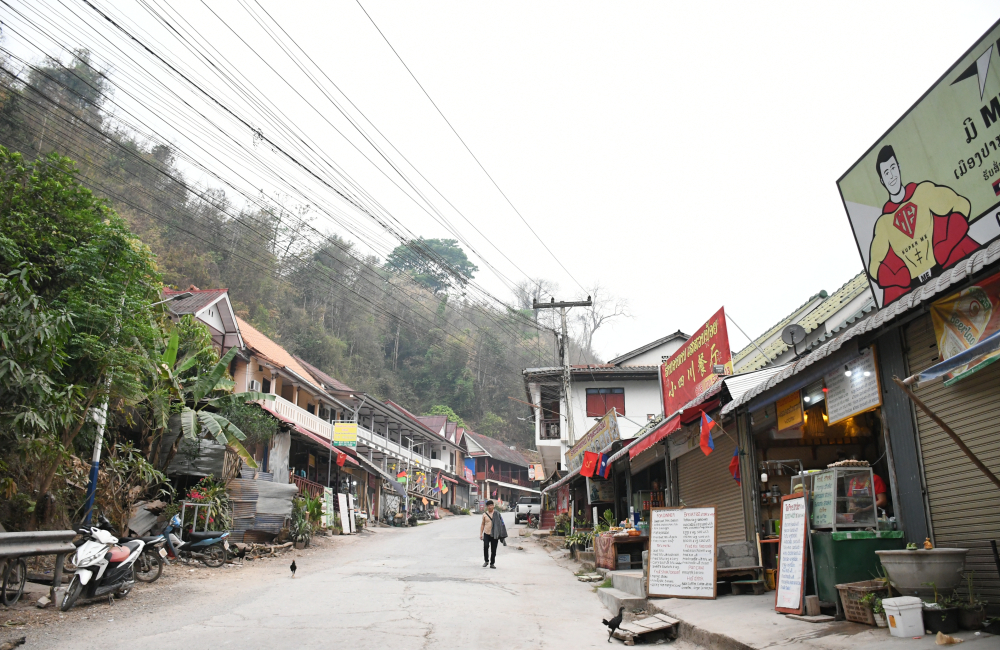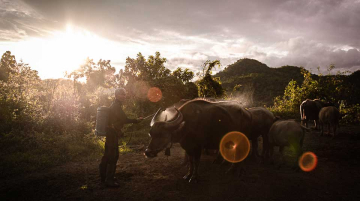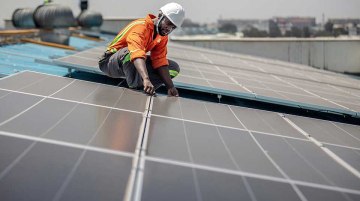
Pak Beng is a small, sleepy town north of Laos. Little happens in this town except when the slow boat emerges on the Mekong River pier at six in the evening. When that happens, shops, bars, and restaurants near the pier come alive to greet arriving tourists.
Like many rural towns in Laos, Pak Beng lacks infrastructure. However, about two months ago, a small development startled some residents. They discovered a company planning to build a new hydropower dam nearby.
“There was an official team in [town] about two months ago inspecting the site,” a shopkeeper told CGSP. Another town dweller, La, said he had seen workers’ camps up at the dam’s site some fifteen kilometers north of the town.
Located about 530 kilometers south of China’s Jinghong dam—also on the Mekong River—the Pak Beng dam will be Laos’ uppermost mainstream dam. The major shareholders are China Datang Overseas Investment and Thailand’s Gulf Energy Development PCL.
Construction has yet to start, but buyers are already queuing. Thailand’s Electricity Generating Authority (EGAT) plans to purchase electricity from the Pak Beng dam for 29 years beginning in 2033. The dam will cost $1.88 billion and provide 912 megawatts of electricity.
Hydropower has been central to Laos’ economy, and China and Thailand have played major roles. However, China has recently stepped up its role in Laos’ energy sector.
In March 2021, Laos’ state-owned corporation Électricité du Laos gave a 25-year concession agreement to state-owned enterprise China Southern Power Grid Company to develop powerlines in the country. The deal was inked amid concerns that the Lao government had handed control of basic infrastructure to foreign governments.
China is already Laos’ most prominent foreign donor and investor, mainly through railway and road investments under the Belt and Road Initiative, amounting to $7 billion, roughly 39 percent of GDP.
A landlocked nation with a majority of its 7.5 million population living in rural areas and largely untapped natural resources, the government launched the “Battery of Asia” policy in the early 2000s to attract investments in return for revenue from selling electricity to neighboring countries. Foreign money has since poured into the sector, but with that has come scrutiny on ecological impacts and displacements.

The new Pak Beng dam triggered concerns among the Mekong River communities in Thailand. After all, Pak Beng is only a few hours away from Thailand’s Mekong provinces in the north and northeast.
A group representing Thai residents of eight provinces in the Mekong Basin warned Thai Prime Minister Srettha Thavisin that if the backwater effect occurs, the Mekong River will turn into a year-round reservoir, flooding areas on either side of its banks. Backwater effects happen when the water level rises due to the blockade of natural flows.
Back in Laos, the government plans to resettle around 4,700 people from over 700 households to make way for the construction of the Pak Beng dam. When Pak Beng dam operations tentatively begin in 2033, it will join a raft of almost a dozen Mekong dams in Laos. Some are already in operation, and some are under construction or in the planning stage.
Bad Experience
Pak Beng residents have borne the brunt of a dam project.
Seven years ago, a Chinese state-owned engineering company called China National Electric Engineering built the Nam Beng dam about ten kilometers north of the town. In mid-March, the area of the river downstream behind the reservoir door was arid. The reservoir itself was full of water.
Tee, a 65-year-old Pak Beng dweller, recalled how her house was flooded with water after the Nam Beng dam began operations in 2016. The tide swept away her 150 chickens and eight swine. After the incident, the government did not pay for her losses. Instead, they moved her to a new location.
The government gave Tee a piece of land to build a new house. “The Chinese built the dam, but they didn’t help,” Tee said. Today, Tee maintains some cattle and farmlands up on the hill to maintain livelihoods.
Tee and other villagers affected by the Nam Beng dam now live in a new village built by the government, about five kilometers from the reservoir. Unlike sporadic agricultural settlements seen in Pak Beng or other rural areas of Laos, this village bears signs of planning. There are rows of houses and some junctions, although only parts of the roads here are concrete. A resident said about 300 families moved to this area in the past few years.
Another resident, Som, told CGSP how the tide swept her house away in 2018. Lao officials visited them after the flood and said, “If you said that this was the water from the dam, we’ll put you in jail.”
“The dam released the water for three days and three nights. But officials [insisted] it was the water from a natural source,” Som said. To make her family leave, officials cut the electricity and water at her house, she added.
Ian Baird, an expert on Mekong ecology at the University of Wisconsin-Madison, said that most residents impacted by the dams only get one-time compensation. He believed that it was not fair compensation, considering the long-term impacts that residents had to bear.
“The biggest problem is usually finding resettled people with good agricultural land for them to cultivate. Therefore, people are rarely better off than before and are almost always much worse off than they were,” Baird said. He added that some people outside of the reservoir areas rarely receive compensation.
Water Control
China plays a significant role in building most dams along rivers across Southeast Asia, including the Mekong River. But it has its own geopolitical headaches.
Beijing has been accused of holding back water upstream during droughts. Other Mekong nations, including Laos, Thailand, Cambodia, and Vietnam, have called on China to share water data.
According to the Stimson Center’s Mekong Infrastructure Tracker, there are currently 11 dams on China’s part of the Mekong River alone. China has also invested in at least 35 other dam projects in Laos, Vietnam, Myanmar, and Cambodia.

In Laos, Chinese firms are involved in three planned dams on the Mekong River’s mainstream: Pak Lay, Pak Beng, and Sanakham. Thai firms are engaged in the rest of Laos’ mainstream dams, except for the Malaysia-funded Don Sahong dam.
As of early 2023, Lao PDR produced power from 76 hydropower dams, with another 43 still under construction. Thailand is now the largest investor in megawatts produced, followed by China and Vietnam.
“There is such a high number of dams in Laos, both on the Mekong and its tributaries, because Laos has no industry,” said Thai economist Aat Pisanwanich.
“Laos’ only revenue sources are tourism and electricity. There is a high demand for electricity from its neighboring countries, such as Vietnam, which experiences frequent blackouts. Thailand is also a major buyer of Laos’ electricity,” he said.
China and Thailand will likely remain major actors in Laos’ hydropower sector. “China has provided considerable support for developing hydropower energy in Laos,” said Baird, the Mekong ecology expert. “However, the negative social and environmental impacts have not been appropriately mitigated or compensated for, resulting in serious negative impacts,” he warned.
*Names of Lao sources have been changed for safety reasons.











